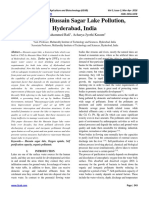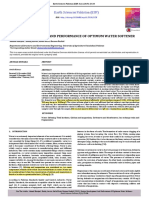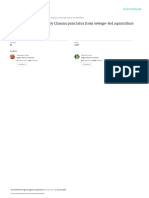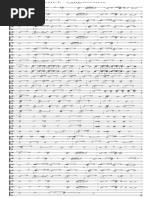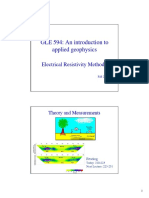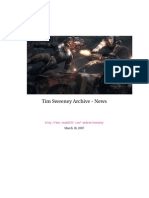Effects of Ganesh-Idol Immersion On Some Water Quality Parameters of Hussainsagar Lake
Effects of Ganesh-Idol Immersion On Some Water Quality Parameters of Hussainsagar Lake
Uploaded by
Smarat VermaCopyright:
Available Formats
Effects of Ganesh-Idol Immersion On Some Water Quality Parameters of Hussainsagar Lake
Effects of Ganesh-Idol Immersion On Some Water Quality Parameters of Hussainsagar Lake
Uploaded by
Smarat VermaOriginal Title
Copyright
Available Formats
Share this document
Did you find this document useful?
Is this content inappropriate?
Copyright:
Available Formats
Effects of Ganesh-Idol Immersion On Some Water Quality Parameters of Hussainsagar Lake
Effects of Ganesh-Idol Immersion On Some Water Quality Parameters of Hussainsagar Lake
Uploaded by
Smarat VermaCopyright:
Available Formats
SCIENTIFIC CORRESPONDENCE
Effects of Ganesh-idol immersion on some water quality parameters of
Hussainsagar Lake
Immersion of idols of Lord Ganesh is sites of the lake before and after ten days pared to the specifications of highest
carried out every year on the Ananta of the event, following the standard desirable limits of BIS and ICMR
Chaturdasi day in the month of Bhadra- methods1. standards, the concentration of lead in
pada (Chandramana calendar), i.e. either We found that the concentration of the lake water increased more than three-
in August or September, after ten days of calcium had increased significantly in fold, though its average concentration in
worship. Thousands of these idols are the lake water after the idol immersion; the lake water is less than that at the idol-
immersed in different water bodies such however, it was below the limits of immersion sites. However, its concen-
as lakes, reservoirs, ponds, rivers and permissible standards. The average con- tration increased four-fold after the idol
canals in and around different towns and centration of calcium in the lake water immersion. Further, we observed that the
cities in Maharashtra, Karnataka and was much less compared to that at the concentration of mercury, the causative
Andhra Pradesh. These idols are made up immersion sites. Magnesium, molybde- chemical of the famous ‘Minamata’ disease
of plaster of paris, clay, and cloth num and silicon concentrations had also of Japan, is high among that of the other
supported by small iron rods, and are increased significantly in the lake water trace elements in the lake water. It
coloured with different types of paint after the idol immersion. Though magne- increased to more than five to six hundred
such as varnish and watercolours. When sium is non-poisonous, it increases the times in the lake water, including that at
immersed, these coloured chemicals dis- hardness of water. Over the years, the the immersion sites compared to the
solve slowly leading to significant alte- average concentration of heavy metals, specifications of highest desirable limits
ration in the water quality. Thousands of especially arsenic, lead and mercury has as set by BIS and ICMR standards. After
Ganesh idols of various sizes reaching also increased considerably in the lake the immersion of the idols, its concentra-
heights up to 45 to 50 feet are immersed water compared to the specifications of tion increased further, to more than
in the Hussainsagar Lake in the twin highest desirable limits as set by BIS seven-hundred fifty times in the water
cities of Hyderabad and Secunderbad in and ICMR standards (see Table 1). Our (Table 1).
Andhra Pradesh. (The lake is constructed measurements have shown that sub- The heavy metals are known to be
across Kalvaleru stream, one of the sequent to Ganesh-idol immersion, the persistent in the aquatic environment,
tributaries of Musi River passing through concentration of these metals increased and gradually accumulate and magnify
Hyderabad city. It is 3.2 km long and perceptibly. The concentration of arsenic, through the process known as bioaccu-
2.8 km wide; its depth ranging from 2.5 a noxious trace element, has increased mulation and biomagnification, while
to 12.5 m, with a surface area of 446 nine-fold in the lake water after the idol they move up in the food chain. Thus,
hectares.) Similarly, after Durga pooja, immersion, compared to its BIS and lead and mercury may magnify in their
which occurs in the month of October, ICMR standards (Table 1). Excess of this concentrations at different trophic levels,
idols of Goddess Durga are also immersed element causes skin diseases. Though the including in fishes and birds inhabiting
in the lake. concentration of iron in the lake water the lake, which finally reach the humans
Last year, we carried out an investi- did not change much and was below the through food. Organic compounds of
gation to find out the effects of immer- limits of standards, that of lead and mercury, for example methyl mercury
sion of Ganesh idols on water quality of mercury, the potentially obnoxious heavy when it enters the human body, con-
the lake, by collecting and analysing metals, had increased many-fold in the centrates in the brain and destroys the
the water samples from the immersion water due to the idol immersion. Com- brain cells, damaging the central nervous
system, and also causes corrosion and
ulceration of the digestive tract. Thus,
people consuming contaminated fish
caught from the lake over a period of
Table 1. Changes in concentration (mg/l) of some chemical pollutants in Hussainsagar Lake time may get afflicted with mercury
water before and after the immersion of Ganesh idols
poisoning.
Chemical X (mean) conc. Before immersion After immersion BIS and ICMR standards Therefore, it is suggested that the
pollutant in the water of idols of idols for highest desirable limits authorities looking into the environ-
mental protection of the lake need to
Calcium 25.14 43.77 68.4* 75
Magnesium 7.785 6.590 10.02* 30
take necessary steps. Along with other
Molybdenum 0.090 0.149 0.354* Not available measures, including strict implementa-
Silicon 3.537 2.954 3.826** Not available tion of central and state level legislation,
Arsenic 0.124 0.121 0.497 0.05 they should conduct environmental
Iron 0.212 0.125 0.22** 0.3 awareness programmes, may be through
Lead 0.289 0.351 0.45** 0.1
Mercury 0.689 0.5525 0.778** 0.001 different media, particularly before the
‘Vinayakachauti’ day, to educate the
Level of significance: *P < 0.01 and **P < 0.05. public of the city and make them aware
‡
Source: Goel, P. K. and Sharma, K. P., Environmental Guidelines and Standards in India, of the harmful environmental effects
Technoscience Publ., Jaipur, 318 pp.
1412 CURRENT SCIENCE, VOL. 81, NO. 11, 10 DECEMBER 2001
SCIENTIFIC CORRESPONDENCE
of immersion of Ganesh idols in the Waste Water, American Public Health
lake and persuade them not to use this Association, Washington D.C., 1985, 16th M. VIKRAM REDDY*
lake for immersion of Ganesh idols. This edn, p. 1268. A. VIJAY KUMAR
may to some extent reduce the pollution
Department of Zoology,
of water of this languishing urban
Applied Ecology Laboratory,
lake.
ACKNOWLEDGEMENT. We are thankful Kakatiya University,
to an anonymous reviewing editor for his Warangal 506 009, India
1. APHA, AWWA, and WPCP, Standard constructive suggestions and corrections to *For correspondence
Methods for the Examination of Water and improve the manuscript. e-mail: mallapureddymv@yahoo.com
Predation of water bug Sphaerodema rusticum Fabricius on the snail
Pomacea bridgesi (Reeve), introduced in India
Being a native of Peru, Bolivia, Brazil individuals belonging to the remaining 3 dator by pushing its head into the shell
and Paraguay1,2, the ampullariid snails size-groups together in different combi- cavity of the prey-snail trapped. The
Pomacea bridgesi are now thriving well nations, taking at least 2 individuals of a water bug required 25–186 min (average
in Florida3, Hawaii2 and in the countries size-group, to the predator to note the 81 ± 9.07 SE) (n = 18) to predate a single
of south-east Asia4–6, including India7. preference if any, for the specific sized snail. A S. rusticum destroyed 3–9 snails,
They are a serious threat to taro2 and prey individuals. Observations were con- consuming 0–4 (completely) and 2–6
paddy plants8,9, and to gastropod fauna4 tinued for 6 consecutive days in the (partially); and 1–5 snails, consuming 0–
of the introduced areas. Also, the fact former and 39 days in the later experi- 3 (completely) and 0–3 (partially) daily,
that they may be involved with the spread ments. S. rusticum, essentially a sucker of in single and mixed sized-group experi-
of human diseases is of grave concern10. the visceral mass of P. bridgesi, some- ments, respectively. The average predation
Therefore, attempts are being made to times consumed it completely (evident rates are shown in Figure 1 a and b. In
prevent their spread furthermore, and to from dropping of empty shell from the mixed size-group experiments, irrespec-
keep the population density in check. rostrum) and sometimes, partially (evident tive of trials, the water bug destroyed
Though voracity of P. bridgesi is on from dropping of shell containing a 18.92, 36.03 and 45.05% P. bridgesi
record11,12, reports on the organisms portion of visceral mass). It is to be belonging to 2.5–4.5 mm 5.0–7.0 mm
devouring them are still wanting, with a mentioned that, in cases of complete and 7.5–9.5 mm size-groups, respec-
view to develop the control strategy. consumption a small amount of fibre-like tively. ANOVA tests indicate that the
Accordingly, we investigated the same by material, following dropping of the shell, rates of destruction as well as consump-
offering P. bridgesi to the water bug was seen hanging from the tip of the tion of prey snails by S. rusticum differ
Sphaerodema rusticum, the most effec- rostrum of S. rusticum. These fibres significantly (P < 0.05) with the size of
tive predator13,14 of the endemic fresh- were, sometimes consumed or left in the the snails offered. Also, it is evident that
water gastropod species experimentally, water by the bug. Killing of the snails by the rate of destruction of the prey by the
in the laboratory. such types of feeding was termed as predator differs significantly (P < 0.05),
The required number of plastic contai- ‘destruction’. Data were recorded accor- when offered different size-groups, group-
ners (each 135 mm in diameter and 32 mm dingly, with respect to the feeding types, wise or together.
in depth), containing 250 ml pond water, regularly, at the end of every 24 h. The Though some birds and reptiles are
laboratory-reared P. bridgesi belonging snails were fed with lettuce and the water known to feed upon the golden snails in
to the size-groups, 2.5–4.5 mm (the newly of the container was changed daily, South America16, no concerted attempt
hatched snails range from 2.3 to 2.7 mm adding fresh pond water. In all cases, has ever been made to survey the inver-
in shell length), 5.0–7.0 mm, 7.5–9.5 mm, mean and standard error (SE) were tebrates and microorganisms that attack
10.0–12.0 mm and 12.5–14.5 mm in shell calculated to present the data. One-way them in their native habitats6. However, a
length, and pond-collected adult S. rusti- analysis of variance (ANOVA)15 was pyrrochorid bug, Dindymus pulcher and
cum were considered for the experiment. applied to ascertain whether the size of the nymphs of firefly, Luciola lateralis
In all cases, 15 snails were exposed to a the prey individuals has significant impact are known to feed on P. canaliculata in
single water bug in a container, for a on predation. the Philippines6 and Japan17, respec-
period of 24 h. Initially, experiments S. rusticum was seen to penetrate its tively. The results of the present investi-
were performed with the snails with rostrum into the visceral mass, suddenly gation clearly indicate that the water bug,
regard to their size-group, separately. when the snail opened its operculum. S. rusticum, is a voracious feeder of
Since the water bugs failed to capture the The snail tried to close the opercu- juvenile P. bridgesi and thereby, is effec-
snails belonging to 10–12 mm and 12.5– lum, but failed to operate the same due to tive in killing more number of indivi-
14.5 mm size-groups, we finally supplied the strong barrier created by the pre- duals, daily. It is most likely that if the
CURRENT SCIENCE, VOL. 81, NO. 11, 10 DECEMBER 2001 1413
You might also like
- Electrical Engineering Project AssignmentNo ratings yetElectrical Engineering Project Assignment3 pages
- Im Acco 01bc Fundamentals of Accounting Part 1100% (1)Im Acco 01bc Fundamentals of Accounting Part 1110 pages
- The Effect of Ganesh Idol Immersion On The Water Quality of Gorai Jetty, Mumbai The Environmental Health PerspectiveNo ratings yetThe Effect of Ganesh Idol Immersion On The Water Quality of Gorai Jetty, Mumbai The Environmental Health Perspective5 pages
- Irjet Water Pollution Due To Idol ImmersNo ratings yetIrjet Water Pollution Due To Idol Immers5 pages
- The Spatial Distribution of Heavy Metal Lead and Cadmium Pollution and Coliform Abundance of Waters and Surface Sediment in DemakNo ratings yetThe Spatial Distribution of Heavy Metal Lead and Cadmium Pollution and Coliform Abundance of Waters and Surface Sediment in Demak12 pages
- 2010 IER HeavyMetalsinWaterSedimentFishesofBurigangaR - BGD RightNo ratings yet2010 IER HeavyMetalsinWaterSedimentFishesofBurigangaR - BGD Right13 pages
- Review of Hussain Sagar Lake Pollution, Hyderabad, IndiaNo ratings yetReview of Hussain Sagar Lake Pollution, Hyderabad, India7 pages
- 2023 IOP Conf Ser Earth Environ Sci 1209 012023-1No ratings yet2023 IOP Conf Ser Earth Environ Sci 1209 012023-16 pages
- ID Kandungan Logam Berat HG CD Dan PB Dalam Air Tanah Pada Perumahan Tipe Kecil Di PDFNo ratings yetID Kandungan Logam Berat HG CD Dan PB Dalam Air Tanah Pada Perumahan Tipe Kecil Di PDF10 pages
- Design Development and Performance of Optimum WateNo ratings yetDesign Development and Performance of Optimum Wate6 pages
- Assessment of Physico Chemical Characteristics of Groundwater Quality of Ajmer City in RajasthanNo ratings yetAssessment of Physico Chemical Characteristics of Groundwater Quality of Ajmer City in Rajasthan3 pages
- Neela Hauz Biodiversity Park Biodiversity ParkNo ratings yetNeela Hauz Biodiversity Park Biodiversity Park2 pages
- Revival of Hauz Khas Lake A Historic Lake in Urban DelhiNo ratings yetRevival of Hauz Khas Lake A Historic Lake in Urban Delhi11 pages
- Dilution River and Self Purification PDFNo ratings yetDilution River and Self Purification PDF7 pages
- Heavy Metals Contamination Level and Water Quality Parameter Conditions in Jatiluhur Reservoir, West Java, IndonesiaNo ratings yetHeavy Metals Contamination Level and Water Quality Parameter Conditions in Jatiluhur Reservoir, West Java, Indonesia11 pages
- Determining The Water Quality Index of An Urban Water Body Dal Lake, Kashmir, IndiaNo ratings yetDetermining The Water Quality Index of An Urban Water Body Dal Lake, Kashmir, India8 pages
- Effect On Humans Due To Deposition of Heavy Metals in Weras River and Remediation TechniquesNo ratings yetEffect On Humans Due To Deposition of Heavy Metals in Weras River and Remediation Techniques8 pages
- Water Resources and Industry: M. Sarkar, A.K.M.L. Rahman, N.C. BhoumikNo ratings yetWater Resources and Industry: M. Sarkar, A.K.M.L. Rahman, N.C. Bhoumik6 pages
- Universiti Teknologi Mara: Name: Ain Athirah Binti RahimiNo ratings yetUniversiti Teknologi Mara: Name: Ain Athirah Binti Rahimi20 pages
- River Health.: Self-Purification Will Take Less Tim at Hot Temperature Than in WinterNo ratings yetRiver Health.: Self-Purification Will Take Less Tim at Hot Temperature Than in Winter4 pages
- How Idol Immersion Is Polluting The Ganga River in Kolkata, West Bengal: An Overview Medical ScienceNo ratings yetHow Idol Immersion Is Polluting The Ganga River in Kolkata, West Bengal: An Overview Medical Science4 pages
- Assessment of Salt Water Intrusion Into The Coastal Aquifers of KeralaNo ratings yetAssessment of Salt Water Intrusion Into The Coastal Aquifers of Kerala4 pages
- Pengaruh Penambahan Naoh Dan Ca (Oh) Terhadap Penurunan Kadar Logam Berat (Fe) Di Kolong Tambang 23 Desa Kimhin Kecamatan SungailiatNo ratings yetPengaruh Penambahan Naoh Dan Ca (Oh) Terhadap Penurunan Kadar Logam Berat (Fe) Di Kolong Tambang 23 Desa Kimhin Kecamatan Sungailiat6 pages
- 1-Criteria For Water Quality Monitoring - Water Quality-19!6!18No ratings yet1-Criteria For Water Quality Monitoring - Water Quality-19!6!1872 pages
- Remobilization of Trace Metals Induced by Microbiological Activities Near Sediment-Water Interface, Aha Lake, GuiyangNo ratings yetRemobilization of Trace Metals Induced by Microbiological Activities Near Sediment-Water Interface, Aha Lake, Guiyang5 pages
- The Behavior of Silica in Geothermal Brine From Dieng Geothermal Power Plant, Indonesia PDFNo ratings yetThe Behavior of Silica in Geothermal Brine From Dieng Geothermal Power Plant, Indonesia PDF6 pages
- An Experimental Study For The Removal of Hardness of Water by Using BiosorbentsNo ratings yetAn Experimental Study For The Removal of Hardness of Water by Using Biosorbents7 pages
- InTech-Inland Desalination Potentials and Challenges1No ratings yetInTech-Inland Desalination Potentials and Challenges133 pages
- Religious_activities_and_their_impacts_on_the_surfNo ratings yetReligious_activities_and_their_impacts_on_the_surf15 pages
- 1st Grade of Junior High School: Τeacher'S BookNo ratings yet1st Grade of Junior High School: Τeacher'S Book199 pages
- Kebele_House_Rent_and_Record_Management_System_v2No ratings yetKebele_House_Rent_and_Record_Management_System_v23 pages
- EEA-430 Introduction To Mechatronics: D R. Abdul Attayyab Khan Email AddressNo ratings yetEEA-430 Introduction To Mechatronics: D R. Abdul Attayyab Khan Email Address18 pages
- Chap - 05 - Deck Machinery and Cargo EquipmentNo ratings yetChap - 05 - Deck Machinery and Cargo Equipment31 pages
- Mock Drill Calendar 2023-24: Sr. No. Month Type of Mock Drill ROM-50-VIINo ratings yetMock Drill Calendar 2023-24: Sr. No. Month Type of Mock Drill ROM-50-VII4 pages
- Lewisburg Area School District Lesson PlanNo ratings yetLewisburg Area School District Lesson Plan2 pages











